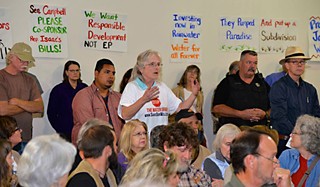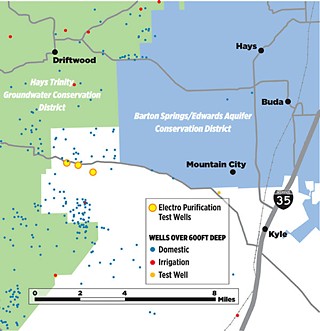Private drilling threatens public water supply
By Vicki Wolf, Fri., April 3, 2015
Rumblings from Hays County are reaching the state Capitol, reverberating over a groundwater well project that opponents say could draw more water from the Trinity Aquifer than all the currently permitted well production in western Hays County. In recent weeks, citizens who get most of their drinking water from the Aquifer bombarded state representatives with calls and emails. It was standing room only March 25 at a House Natural Resources Committee hearing on bills filed by Rep. Jason Isaac, R-Dripping Springs, to stop the project. Since early February, community meetings have been packed with concerned citizens, thousands have signed a petition opposing the project, and a Hill Country coalition – the Trinity Edwards Springs Protection Association – has filed a lawsuit to stop the drilling."While I see Buda and others need water, they shouldn't be able to take our water," said environmental attorney Jim Blackburn, who is providing pro bono legal counsel for the TESPA lawsuit. He has a home in Wimberley, two miles from the well field where EP is drilling for water on land leased from a local property owner.
EP says it's providing solutions to water demand that local jurisdictions have not addressed. "What government agencies couldn't deliver, EP accomplished," said Tim Throckmorton, EP's manager. "We are happy to see Hays County water going to Hays County communities." A consultant for EP explained that the company is monitoring the wells to measure the effects on surrounding wells, and plans to share that data to "build a scientifically based model of how much water is truly available."
But according to a study by LBG-Guyton Associates, pumping that much water from western Hays County is likely to leave residents who depend on wells in the area without water. Currently, EP has six producing wells, capable of producing 2.5 MGD (millions of gallons per day). The Guyton study looked at a five-mile area around the EP well field and found that if EP produces 5.3 MGD for one year, the water level near the well field would drop more than 500 feet. Even at 3 MGD, residential wells in the area would see a significant drop in water levels.
 |
Citizens protest the groundwater well project during a
Feb. 10 town hall meeting, hosted by state Rep. Jason Isaac.
Courtesy of Steve Wood
|
Facing this reality, Bond has explored the cost to lower her well pump, dig a deeper well, or install a rainwater harvesting system. She found a 700-foot well would cost $28,000. "Just to lower the pump is quite expensive, and won't begin to deal with the drawdown," Bond explained. A rainwater harvesting system would cost $20,000. "But why should we have to do those things? Don't I have a right to the fair use of the water under my land?"
As Texas law stands today, EP can legally take all the water it wants from the Aquifer. Protected by the state's "rule of capture," the property owner with the biggest pump usually wins when sued by neighbors who are having their water sucked out from under them. The only protection those with smaller pumps have is the authority granted by Texas law to create regional groundwater conservation districts to limit excessive pumping. EP is taking advantage of a loophole in the rule of capture – the company is drilling in a Hays County "white zone" – not covered by any conservation district.
TESPA has sued to stop EP's drilling until the company obtains groundwater use permits from the Hays Trinity Groundwater Conservation District, arguing that that district has default jurisdiction over groundwater in parts of the county not covered by another district. The suit also has a much larger ambition: to overturn the rule of capture.
David Baker, executive director of the Wimberley Valley Watershed Association, one of the coalition parties in TESPA, says Texas aquifers should be maintained for sustainability. "Over-pumping aquifers to fuel unmanaged growth is irresponsible," he said. "It threatens our economy, our springs, and our surface water."
Two of the three bills filed by Isaac and considered at the Natural Resources Committee hearing were aimed at closing the loophole used by EP, instead giving either HTGCD or Barton Springs/Edwards Aquifer District the authority to manage the white zone. The third bill would remove Goforth Special Utility District's eminent domain authority for areas outside its geographic boundaries – without the use of eminent domain, the pipeline to transport water out of the area couldn't be built.
The House committee heard hours of testimony from people who tried to explain groundwater science; reports from residents and local water authorities disputed the EP consultant's reports of the project's likely impact on area water levels. In the end, committee members were reluctant to get involved in the dispute, especially with a lawsuit under way, and the three bills were left pending in committee – or, as HTGCD board President Linda Kaye Rogers put it, "The bills were left floating in the water, as long as there is water to float in."
If the Legislature fails to reform regulation of groundwater, and EP is allowed to proceed and take all the water it can sell from the Trinity Aquifer, such disputes will not be confined to Hays County. There are plenty more white zones for water marketers to exploit: 24% of the state's land area is currently not covered by any groundwater conservation district.

No comments:
Post a Comment